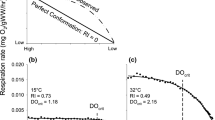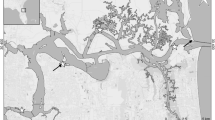Summary
The rates of oxygen consumption, filtration and ammonia excretion by Mytilus californianus have been related to body size and to ration. The rate of oxygen consumption (VO2) by individuals while immersed, measured on the shore, resembled rates recorded for mussels starved in the laboratory. VO2 by M. californianus was relatively independent of change in temperature, with a Q 10 (13–22° C) of 1.20. In contrast, the frequency of heart beat was more completely temperature dependent [Q 10 (13–22° C)=2.10]. Filtration rate showed intermediate dependence on temperature change [Q 10 (13–22° C)=1.49] up to 22° C, but declined at 26° C. Both VO2 and filtration rate declined during starvation. The utilisation efficiency for oxygen was low (approx. 4%) between 13 and 22° C, but increased to 10% at 26° C. Three components of the “routine” rate of oxygen consumption are recognised and estimated; viz. a basal rate (0.136 ml O2 h-1 for a mussel of 1 g dry flesh weight), a “physiological cost” of feeding (which represented about 6% of the calories in the ingested ration), and a “mechanical cost” of feeding which was three times higher than the physiological cost. The ratio oxygen consumed to ammonia-nitrogen excreted was low, and it declined during starvation. These data are compared with previously published measurements on Mytilus edulis, and the two species of mussel are shown to be similar in some of their physiological characteristics, though possibly differing in their capacities to compensate for change in temperature. For M. californianus, the scope for growth was highest at 17–22° C and declined at 26° C; it is suggested that exposure to temperatures in excess of 22° C, as for example during low tides in the summer, might result in a cumulative stress on these populations of mussels by imposing a metabolic deficit which must be recovered at each subsequent high tide. The high “mechanical cost” of feeding imposes a more general constraint on the scope for activity of the species.
Similar content being viewed by others
References
Bayne, B. L.: Oxygen consumption by three species of lamellibranch mollusc in declining ambient oxygen tension. Comp. Biochem. Physiol. 40A, 307–313 (1971a)
Bayne, B. L.: Ventilation, the heart beat and oxygen uptake by Mytilus edulis L. in declining oxygen tension. Comp. Biochem. Physiol. 40A, 1065–1085 (1971b)
Bayne, B. L.: Physiological changes in Mytilus edulis L. induced by temperature and nutritive stress. J. mar. biol. Ass., U.K. 53, 39–58 (1973a)
Bayne, B. L.: Aspects of the metabolism of Mytilus edulis during starvation. Neth. J. sea. res. 7, 399–410 (1973b)
Bayne, B. L.: Aspects of physiological condition in Mytilus edulis L. with special reference to the effects of oxygen tension and salinity, p. 213–238. In: Proceedings of the 9th European Marine Biology Symposium (H. Barnes, ed.). Aberdeen: Aberdeen University Press 1975
Bayne, B. L., Bayne, C. J., Carefoot, T. C., Thompson, R. J.: The physiological ecology of Mytilus californianus Conrad. 2. Adaptations to low oxygen tension and air exposure. Oecologia (Berl.) 22, 229–250 (1976)
Bayne, B. L., Thompson, R. J., Widdows, J.: Some effects of temperature and food on the rate of oxygen consumption by Mytilus edulis L., p. 181–193. In: Effects of temperature on ectothermic organisms (W. Wieser, ed.). Berlin-Heidelberg-New York: Springer 1973
Chan, G. L.: Subtidal mussel beds in Baja California with a new record size for Mytilus californianus. Veliger 16, 239–240 (1973)
Coe, W. R., Fox, D. L.: Biology of the Californian sea mussel Mytilus californianus. I. Influence of temperature, food supply, sex and age on the rate of growth. J. exp. Zool. 90, 1–30 (1942)
Coe, W. R., Fox, D. L.: Biology of the Californian sea mussel Mytilus californianus. III. Environmental conditions and rate of growth. Biol. Bull. 87, 58–72 (1944)
Connell, J. H.: A predator-prey system in the marine intertidal region. I. Balanus glandula and several predatory species of Thais. Ecol. Monogr. 40, 49–78 (1970)
Corner, E. D. S., Cowey, C. B.: Biochemical studies on the production of marine zooplankton. Biol. Rev. 43, 393–426 (1968)
Dayton, P. K.: Competition, disturbance and community organisation: the provision and subsequent utilisation of space in a rocky intertidal community. Ecol. Monogr. 41, 351–389 (1971)
Dejours, P.: Comparison of gas transport by convection among animals. Resp. Physiol. 14, 96–104 (1972)
Fox, D. L.: The habitat and food of the California sea mussel. Bull. Scripps Inst. Oceanogr. 4, 1–64 (1936)
Fox, D. L., Coe, W. R.: Biology of the Californian sea mussel Mytilus californianus. II. Nutrition, metabolism, growth and calcium deposition. J. exp. Zool. 93, 205–249 (1943)
Fox, D. L., Sverdrup, H. U., Cunningham, J. P.: The rate of water propulsion by the California mussel. Biol. Bull. 72, 417–438 (1937)
Grasshoff, K., Johannsen, H.: A new, sensitive and direct method for the automatic determination of ammonia in seawater. J. Cons. int. Explor. Mer. 34, 516–521 (1972)
Harger, J. R. E.: Competitive coexistence among intertidal invertebrates. Amer. Sci. 60, 600–607 (1972)
Hoggarth, K. R., Trueman, E. R.: Techniques for recording the activity of aquatic invertebrates. Nature (Lond.) 213, 1050–1051 (1967)
Moon, T. W., Pritchard, A. W.: Metabolic adaptations in vertically-separated populations of Mytilus californianus Conrad. J. exp. mar. biol. ecol. 5, 35–46 (1970)
Newell, R. C.: Biology of intertidal animals. London: Logos Press 1970
Paine, R. T.: Intertidal community structure. Experimental studies on the relationship between a dominant competitor and its principal predator. Oecologia (Berl.) 15, 93–120 (1974)
Petersen, J. A., Fyhn, H. J., Johansen, K.: Ecophysiological studies of an intertidal crustacean, Pollicipes polymerus (Cirripedia, Lepadomorpha): Aquatic and aerial respiration. J. exp. Biol. 61, 309–320 (1974)
Pickens, P. E.: Heart rate of mussels as a function of latitude, intertidal height and acclimation temperature. Phys. Zool. 38, 390–405 (1965)
Rao, K. P.: Rate of water propulsion in Mytilus californianus as a function of latitude. Biol. Bull. 104, 171–181 (1953)
Rao, K. P.: Tidal rhythmicity of rate of water propulsion in Mytilus and its modificibility by transplantation. Biol. Bull. 106, 353–359 (1954)
Segal, E., Rao, K. P., James, T. W.: Rate of activity as a function of intertidal height within populations of some littoral molluscs. Nature (Lond.) 172, 118–1109 (1953)
Snedecor, G. W., Cochran, W. G.: Statistical methods. Iowa: Iowa State University Press 1972
Thompson, R. J., Bayne, B. L.: Some relationships between growth, metabolism and food in the mussel, Mytilus edulis. Mar. Biol. 27, 317–326 (1974)
Vahl, O.: Efficiency of particle retention in Mytilus edulis L. Ophelia 10, 17–25 (1972)
Warren, C. E., Davis, G. E.: Laboratory studies on the feeding, bioenergetics and growth of fish, p. 175–214. In: The biological basis of freshwater fish production (S. D. Gerking, ed.). Oxford: Blackwell 1967
Whedon, W. F., Sommer, H.: Respiratory exchange of Mytilus californianus. Z. vergl. Physiol. 25, 523–528 (1937)
Widdows, J.: The effects of temperature on the metabolism and activity of Mytilus edulis L. Neth. J. sea res. 7, 387–398 (1973a)
Widdows, J.: Effect of temperature and food on the heart beat, ventilation rate and oxygen uptake of Mytilus edulis. Mar. Biol. 20, 269–276 (1973b)
Widdows, J., Bayne, B. L.: Temperature acclimation of Mytilus edulis with reference to its energy budget. J. mar. biol. Ass., U.K. 51, 827–843 (1971)
Young, R. T.: The distribution of the mussel Mytilus californianus in relation to the salinity of its environment. Ecology 22, 379–386 (1941)
Author information
Authors and Affiliations
Rights and permissions
About this article
Cite this article
Bayne, B.L., Bayne, C.J., Carefoot, T.C. et al. The physiological ecology of Mytilus californianus Conrad. Oecologia 22, 211–228 (1976). https://doi.org/10.1007/BF00344793
Received:
Issue Date:
DOI: https://doi.org/10.1007/BF00344793




